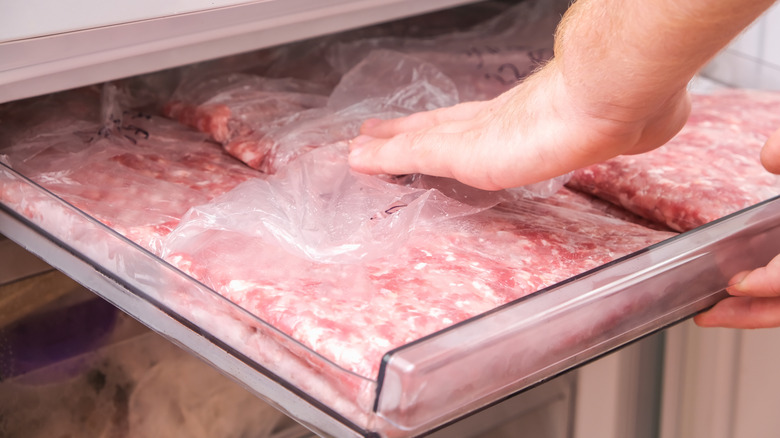Defrosting Ground Beef Has Never Been Faster Thanks To This Freezing Hack
We've all been there: you're all ready to get cooking when you realize — gasp — you never took your ground beef out of the freezer. There are various ways to try to rectify the situation, each with differing levels of effectiveness and food safety. But if you follow one simple technique, you can make defrosting ground beef a breeze.
This tip comes to us courtesy of Imam Rafiq, CEO at Halal Watch World LLC, and it's all about how much of the meat is exposed. "Spreading ground beef into a flat shape is said to accelerate the thawing process by increasing surface area and heat transfer area," Rafiq says. "A flat patty, ½ inch thick, has twice as much surface area as [a] thick chunk and will thaw in [four to six hours] in the refrigerator (instead of the requisite 12-plus hours for the fat lump)."
According to Rafiq, the underlying principle is heat conduction. "Thinner forms lose cold more quickly as warm air or water touches more of the meat's surface," he explains. This trick doesn't just apply to defrosting in the fridge — it also works for one of the better ways to thaw frozen steak quickly: in a bowl of cold water. Thawing a thin frozen patty can cut the defrost time in half compared to a burger ball. It's also significantly safer than leaving meat out on the counter to defrost at room temperature, which is an easy way to breed harmful bacteria.
How to defrost ground beef without compromising its texture
There's a good chance that in your time as a cook, you've made mistakes that everyone makes when defrosting meat. Some of these, like leaving the meat in paper or Styrofoam packaging, can seriously impact the texture as it thaws. This is because the ice crystals that have formed start to break down the protein during defrosting. Luckily, this is something Imam Rafiq is aware of, and he has advice on how to avoid it.
"To defrost flat-frozen beef without compromising its texture, I place it in a sealed plastic bag (preferably a leak-proof one) and immerse it in cold water for 30 to 60 minutes, exchanging the water halfway to maintain a constant temperature," he says. Rafiq warns that this method isn't necessarily the fastest, but it works more evenly and is less prone to creating a mushy mess than using hot water or the microwave — which you should never use to thaw frozen protein.
"Alternatively, I thaw in the fridge overnight [six to eight hours] if I'm planning ahead," he says, emphasizing that drying the meat after thawing is crucial. This step removes excess moisture that could prevent the Maillard reaction, which is essential for proper browning during cooking. "This approach, perfect for halal burgers or kebabs, ensures my ground beef stays tender and flavorful every time," he says.


